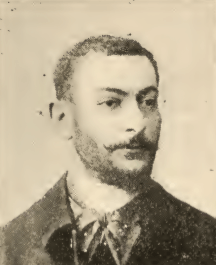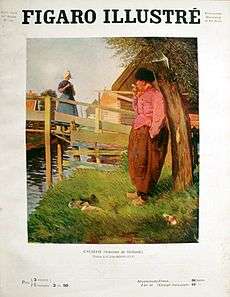Jules Benoit-Lévy
Jules Benoit-Lévy (Paris 27 February 1866, Nogent-sur-Marne 14 March 1952[1]) was a French painter and printmaker.[2]
Jules Benoit-Levy | |
|---|---|
 Jules Benoit-Lévy, 1896 | |
| Born | 27 February 1866 |
| Died | 14 March 1952 (aged 86) |
| Nationality | French |
| Education |
|
| Known for | Painter |
| Movement | Realism and Impressionism |
| Awards | Officier de l'Instruction Publique (Golden Palms) |
Biography

Jules Benoit-Lévy is the son of Baruch Benoit-Lévy (1821-1884) and Julie Strasburger (1826-1901). At the Paris School of Decorative Arts, he studied under Gustave Boulanger and Henri Lucien Doucet, then entered the Jules Joseph Lefebvre workshop at the School of Fine Arts in Paris.[3]
History and sea painter, he also worked on paintings featuring cardinals in anecdotal everyday situations theme in vogue at the time.
Benoit-Lévy exhibited his paintings at the Petite Gelerie Drouot, 23 rue Drouot in Paris.[4]
After trying himself in various genres, Jules Benoit-Levy went to the Netherlands, and stayed at the island of Marken. He created fifty paintings that show sensitive and specific nature of these places.
More than his finished paintings, where result sometimes betrayed the effort, his precise observations are very interesting: sometimes clear, beautiful brightened colours, green or orange, sometimes grey and veiled in mist; unlike, the atmosphere is exactly stated and we will taste the free expansion of talent in all the freshness of his sincerity. In 1902 he exhibited in Paris fifty paintings he made during a stay in the Netherlands, on the theme of everyday life and typical interiors.[5]
Benoit-Lévy exhibited his paintings at the Salon des Artistes Français in Paris and received a third medal in 1895, honorable mention in 1901, and a third class medal in 1911.
In 1911 and 1912, Jules Benoit-Lévy exhibited in Monte-Carlo in Palais des Beaux-Arts at the Exposition Internationale.[6][7]
In 1911[8] to 1930, he exhibited at the Salon D'Hiver in Grand Palais.[9]
He was awarded the Golden Ordre des Palmes Académiques (Officier de l'Instruction Publique)[10]
Works
- The soup of the squad; at the manceuvers[11]
- Combat a Tinténiac, près Rennes, 1793[12]
- Examination of the Prince of T.[13]
- La Défense de Rambervillers (Vosges) en 1870[14]
- Sentry reposing, 1793[15]
- La Bretagne[16]
- The arrest of Condorcet[17][18]
- 14 th July 1789. En route to take the Bastille[19]
- Death of General Moulin; Cholet, 1794[20]
- Dutch Home[21]
- Het Breistertje[22]
- Dutch Home[23]
- Evening; - near Amsterdam[24]
- Good Hope Inn (Holland)[25]
- Evening chat. (Holland)[26]
- Intérieur[27]
- Causerie du soir[28]
- Paneakes at Pont-Croix[29]
- The old chaps (Holland)[30]
- On the dyke (Holland)[31]
References
- Mairie de Paris, Naissances, 3e arr, V4E 266, p.13, № 398, Benoit-Levy
- Pierre Nora -Rethinking France: Les Lieux de Mémoire, Volume 2: Space -2006 - Page 446 "Figure 6.13 Jules Benoît-Lévy, La Bretagne, Salon of 1911"
- Benezit Dictionary of Artists, 2006, site Oxford Index (subscription or library membership required)
- La Chronique des arts et de la curiosité : supplément à la Gazette des beaux-arts; 1901/12/28 (N41), p.336,Art et décoration (Paris), 1903/01 (T13)-1903/06, p.4 Gallica BnF
- La Chronique des arts et de la curiosité : supplément à la Gazette des beaux-arts; 1902/12/20 (N40), p.319, EXPOSITION JULES BENOIT-LÉVY; Gallica BnF
- Le Figaro, 1911/03/07 (Numéro 66), p.4; Monte-Carlo, Palais des Beaux-Arts, Exposition Internationale des Beaux-Arts; Gallica BNF
- Le Figaro, 1912/02/03 (Numéro 34), p.5; Monte-Carlo, Palais des Beaux-Arts, Exposition Internationale des Beaux-Arts; Gallica BNF
- Le Magasin pittoresque / publié.., 1911 (A79,SER3,T12), p.11; Gallica BnF
- Salon d'hiver (Paris), 1930 (25), p.10; Gallica BnF
- Le Figaro, 1906/12/20 (Numéro 354), p.3; Gallica BNF
- Salon 1893; Société des Artistes Français; archive.org
- Salon 1894; Société des Artistes Français, archive.org; Le Monde illustré, 1894/05/05 (A38,T74,N1936), p.296, Gallica BnF
- Salon 1895; Société des Artistes Français; archive.org
- Salon 1896; Société des Artistes Français, archive.org; Légion d'honneur. 1802-1900, p.211 Gallica BnF
- Salon 1897; Société des Artistes Français; archive.org
- La Bretagne, 221 x 150.7 cm.; Musée des Beaux-Arts de Nantes
- Salon 1898; Société des Artistes Français; archive.org
- Journal du dimanche, 1898/05/22 (A43,N2974), p. 451; Gallica BnF
- Salon 1899; Société des Artistes Français; Gallica BnF
- Salon 1900; Société des Artistes Français; archive.org; Musée d'Art et d'Histoire de Cholet
- Salon 1901; Société des Artistes Français, archive.org; Le Magasin pittoresque / publié... 1901 (A69,SER3,T2), p. 753, Gallica BnF
- 1901; Zuiderzeemuseum
- Salon 1902; Société des Artistes Français; archive.org
- Salon 1903; Société des Artistes Français; Gallica BnF
- Salon 1904; Société des Artistes Français; archive.org
- Salon 1905; Société des Artistes Français; archive.org; Duran-Subastas, Nº 495 march 2013 Archived 10 November 2013 at the Wayback Machine
- Les Parisiens de Paris, 1905, p.127; Gallica BnF
- Les Parisiens de Paris, 1905, p.126; Gallica BnF
- Salon 1906; Société des Artistes Français; archive.org
- Salon 1907; Société des Artistes Français; archive.org
- Salon 1908; Société des Artistes Français; archive.org
Notes
- Bénézit, p. 631.
External links
| Wikimedia Commons has media related to Jules Benoit-Lévy. |
- Jules Martin, Nos peintres et sculpteurs, Paris, Flammarion, 1898, volume 2, p. 25. (archive.org)
- Les Parisiens de Paris, 1901, p. 275 (BNF)
- Album "Jules BENOIT-LÉVY (1866-1952)", Pictify
- Famille Benoit-Lévy (généalogie), par Muriel Lévy
- Le Figaro, 1904/08/12 (Numéro 225)
- Le Figaro, 1914/06/17 (Numéro 168), p.5 Jules BENOIT-LÉVY president des Amis de Paris.
- Les Amis de Paris: revue mensuelle illustrée, 1914/01 (A4,N27)-1923/06 (A13,N30), p. 374; Gallica BnF